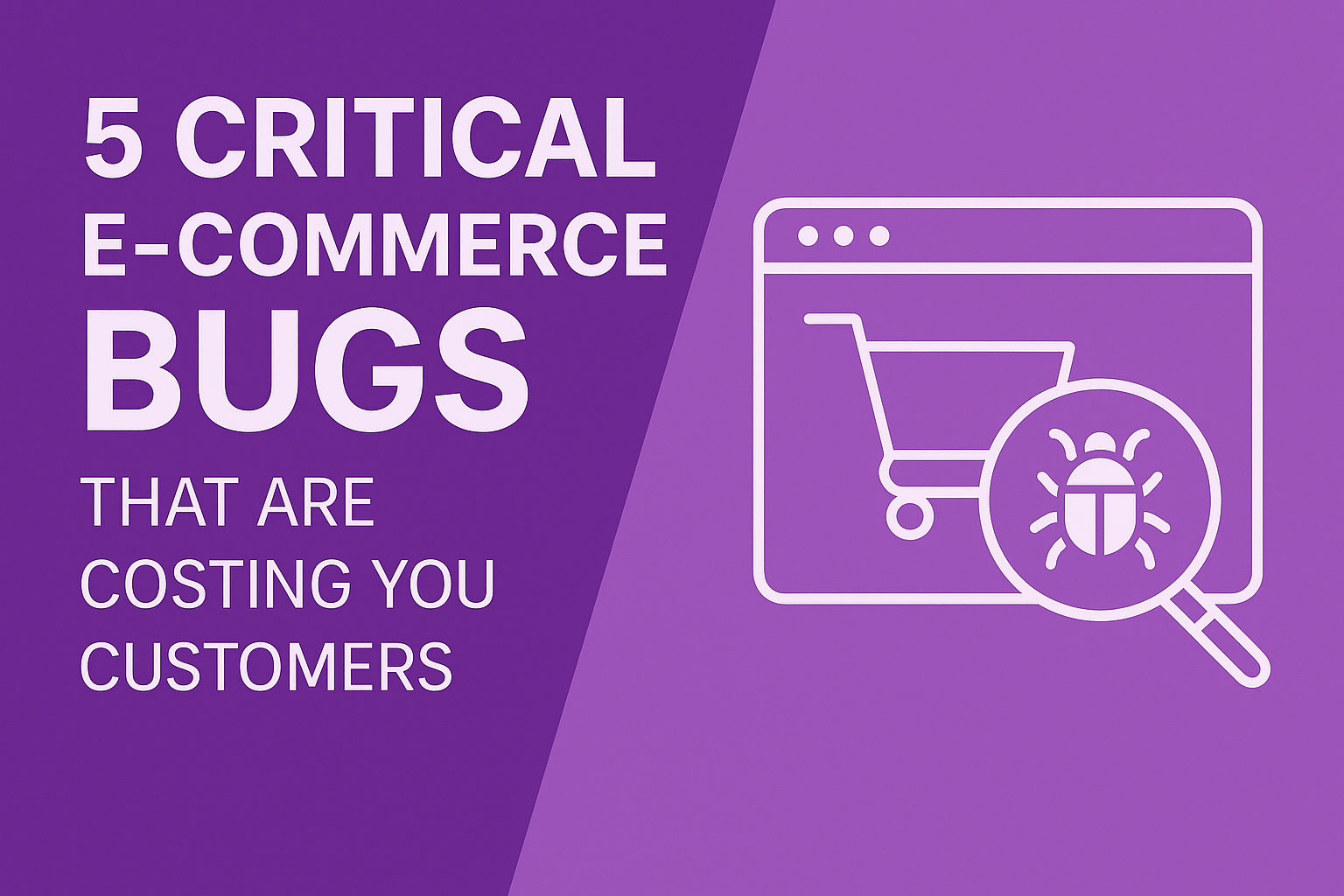The Hidden Cost of Inadequate QA Testing
Before diving into specific bugs, consider this sobering reality: fixing a bug in production costs 10-100 times more than catching it during QA testing. When bugs reach customers, the costs multiply exponentially:
- Immediate revenue loss from failed transactions
- Long-term customer trust damage affecting lifetime value
- Emergency development costs for hotfixes
- Customer service overhead handling complaints
- Negative reviews and word-of-mouth damage
- Potential legal issues with compliance violations
The ROI of proper QA is undeniable. Companies with mature QA processes report 25-40% higher conversion rates and significantly lower customer acquisition costs compared to those treating QA as an afterthought.
Why E-Commerce Bugs Are Business-Critical
Unlike other software applications, e-commerce platforms directly impact purchasing decisions and revenue. When users encounter bugs during their shopping journey, they don't just experience frustration—they immediately lose confidence in your brand's reliability and security.
The stakes are particularly high because:
- Customers have countless alternatives just one click away
- Shopping involves financial transactions requiring absolute trust
- First impressions determine whether visitors become customers
- Word-of-mouth and reviews amplify the impact of negative experiences
This is where strategic QA becomes your competitive advantage. While competitors struggle with buggy user experiences, businesses with comprehensive QA processes deliver the seamless experience that converts browsers into buyers.
1. Missing Items from Wishlist Feed
The Business Impact
Users save items to their wishlist expecting notifications when products return to stock or go on sale. However, a common bug prevents these items from appearing in the wishlist feed, meaning customers never receive crucial back-in-stock alerts.
Cost to your business:
- Lost recurring customers who forget about saved items
- Missed revenue from customers ready to purchase
- Reduced customer lifetime value by 15-30%
- Decreased engagement with wishlist features
How QA Prevents This Disaster
Professional QA teams catch wishlist failures through:
- Comprehensive functional testing of wishlist workflows across all user scenarios
- API testing to ensure wishlist data syncs properly between systems
- Cross-platform testing to verify notifications work on all devices
- Automated regression testing after any inventory or notification system updates
- Database validation to confirm wishlist items persist correctly
QA Best Practice: Implement automated monitoring that continuously tests the entire wishlist-to-notification pipeline, catching integration failures before they affect customers.
2. Broken Product Filters
The Business Impact
Product filtering is essential for helping customers navigate large inventories. When filter bugs show zero results for existing products or display incorrect data, customers abandon their search immediately.
Cost to your business:
- Immediate customer frustration and site abandonment
- Lost sales from customers who can't find desired products
- Reduced conversion rates (up to 50% drop for affected categories)
- Poor user experience metrics affecting SEO rankings
How QA Transforms Filter Reliability
Strategic QA prevents filter failures through:
- Boundary testing of all filter combinations, especially edge cases
- Data validation testing to ensure backend inventory syncs with frontend displays
- Performance testing to prevent timeouts that cause empty results
- Cross-browser compatibility testing for filter JavaScript functionality
- Automated regression suites that test filters after every inventory update
QA Best Practice: Create automated tests that mirror real customer search patterns, ensuring filters work reliably under actual usage conditions.
3. Broken Unsubscribe Functionality
The Business Impact
When customers can't unsubscribe from marketing emails, they mark messages as spam, damaging your sender reputation and potentially violating email regulations.
Cost to your business:
- Damaged email deliverability affecting all future campaigns
- Negative reviews specifically mentioning spam issues
- Potential legal compliance violations (GDPR, CAN-SPAM)
- Reduced trust affecting overall brand perception
- Decreased email marketing ROI across all campaigns
How QA Protects Your Email Reputation
Professional QA prevents unsubscribe failures through:
- End-to-end email testing across different email clients and devices
- Link validation testing for every email campaign before deployment
- Compliance testing to ensure all regulatory requirements are met
- Automated monitoring of unsubscribe functionality in production
- Fallback mechanism testing for alternative unsubscribe methods
QA Best Practice: Implement automated testing that validates every unsubscribe link in real-time, with alerts for any failures that could damage sender reputation.
4. Visual Layout Bugs
The Business Impact
Visual bugs immediately signal unprofessionalism and technical problems. When websites look broken, customers question whether their payment information will be secure and whether orders will process correctly.
Cost to your business:
- Immediate loss of customer confidence and trust
- Reduced conversion rates (visual bugs can decrease conversions by 20-35%)
- Poor mobile experience affecting mobile sales
- Negative brand perception that spreads through social sharing
- Lost credibility that's difficult to rebuild
How QA Ensures Visual Excellence
Comprehensive QA prevents visual issues through:
- Cross-browser and device testing across all major platforms
- Automated visual regression testing that catches layout changes
- Responsive design testing for optimal mobile experience
- Accessibility testing to ensure compliance and usability
- Component integration testing when new features are added
QA Best Practice: Use automated visual testing tools that capture screenshots across different environments, immediately flagging any visual regressions before deployment.
5. Currency Display Errors
The Business Impact
Multi-currency sites should automatically display prices in customers' local currency. When bugs show wrong currencies, international customers abandon purchases due to confusion and uncertainty about actual costs.
Cost to your business:
- Cart abandonment rates increase by 40-60% for affected regions
- Lost international sales and market expansion opportunities
- Customer frustration with unclear pricing
- Reduced trust in international transaction security
- Potential legal issues with price display requirements
How QA Secures Global Commerce
Strategic QA prevents currency bugs through:
- Geolocation testing from different geographic regions
- Multi-currency checkout testing for all supported currencies
- Exchange rate validation to ensure accurate conversions
- Localization testing for region-specific pricing rules
- Payment gateway integration testing across different currencies
QA Best Practice: Implement automated testing that validates currency display and conversion accuracy across all supported regions, with real-time monitoring for exchange rate updates.
Building a QA Culture That Protects Revenue
The Strategic Value of QA Investment
Companies that treat QA as a strategic business function rather than a cost center consistently outperform competitors. Here's why QA is your competitive advantage:
Immediate ROI:
- 60-80% reduction in production bugs
- 25-40% improvement in conversion rates
- 50-70% decrease in customer support tickets
- 10-100x cost savings vs. fixing bugs in production
Long-term Business Benefits:
- Enhanced customer trust and loyalty
- Improved brand reputation and review scores
- Faster time-to-market with confidence
- Reduced development and support costs
- Competitive advantage through superior user experience
Conclusion: QA as Your Competitive Advantage
These five critical bugs represent just the tip of the iceberg. In today's competitive e-commerce landscape, customers have zero tolerance for broken functionality, and competitors are eager to capture frustrated users.
The businesses that thrive are those that recognize QA as a strategic differentiator, not a cost center.
While competitors struggle with buggy user experiences and expensive hotfixes, companies with mature QA processes deliver the seamless, trustworthy experience that converts visitors into loyal customers.





